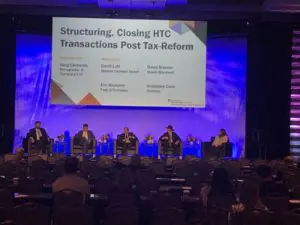Historic Tax Credit
Tax credits remain one of the most powerful financial tools for incentivizing investment in key areas such as renewable energy, historic preservation, and clean manufacturing. More than just financial incentives, they play a crucial role in accelerating clean energy adoption, revitalizing communities, and supporting domestic industries. The Inflation Reduction Act (IRA) has transformed the tax credit landscape, providing long-term stability and introducing new mechanisms such as credit transferability and direct pay. Currently, the market continues to experience significant growth, fueled by increased demand for clean energy projects and historic building revitalization. The IRA has strengthened the Investment Tax Credit (ITC) and Production Tax Credit (PTC), while also implementing technology-neutral tax credits, such as the Clean Electricity Production Tax Credit (45Y) and the Clean Energy Investment Tax Credit (48E), which became effective in 2025. These developments have attracted a broader range of investors, including new corporate buyers looking to offset their tax liabilities. Additionally, the transferability market has matured, allowing tax credits to be sold for cash, reducing reliance on traditional tax equity financing and enabling more participants to benefit. The final regulations released by the IRS in 2024 have provided clear guidance on credit transfer procedures, pre-registration requirements, and compliance considerations, leading to a rapidly expanding tax credit marketplace. What Does the Future Hold for the Tax Credit Market? The future of the tax credit market continues to be shaped by regulatory developments, economic conditions, and policy shifts. Several key factors are influencing its trajectory: Implementation of IRA Tax Provisions: With the IRS finalizing regulations for direct pay and credit transfers, investors now have clear pathways to efficiently utilize tax credits. Energy storage projects, previously ineligible, now qualify for the ITC, opening new opportunities for financing. Political and Legislative Risks: While the IRA has provided long-term certainty, future budget negotiations,…
Read MoreHistoric preservation goes beyond the architectural beauty of a building. It is an important way to transmit the understandings of the past to future generations and preservation of the history helps tell these stories. The federal government realized the importance of these historic sites and implemented the Federal Historic Preservation Tax Incentives program that will encourage private sector investment in the rehabilitation and re-use of historic buildings. At a state-level, 37 states have adopted the state historic tax credit program and are transforming underutilized historic buildings to create more inclusive and resilient communities. What are Historic Tax Credits? Historic Tax Credits (HTC) are a federal tax credit program that provides investors with a 20% credit against the costs of rehabilitating eligible historic structures. This program was established in 1978 and has facilitated the rehabilitation of over 42,000 certified historic buildings. Administered through the National Park Service, Internal Revenue Service (IRS) and State Historic Preservation Offices, it has created over thousands of jobs and turned out to be the nation’s most successful and cost-effective community revitalization program. At the state-level, Historic Tax Credits complement the federal program by providing additional incentives, leading to even greater financial benefit for property owners. 70% of states have adopted some form of historic tax credit incentive to support building reuse and the preservation policy. What Does This Mean for Property Owners, Developers and Investors? Let’s take a look at HTCs on a federal level. Property owners can claim tax credits for up to 20% of qualified rehab expenses and this can offset the cost of rehabilitation to make projects financially viable for owners. As for developers, HTCs will incentivize developers to renovate, restore, and reconstruct the historic buildings. No other tax credit provides as much incentive to preserve and restore historic sites as the federal…
Read MoreFoss & Company 2022 project, Radical Hotel Many companies have long overlooked tax equity investing as part of their tax strategy for different reasons. But this past year has presented new, unique opportunities in the tax equity market for both developers and investors. The Inflation Reduction Act (IRA) has provided more incentives than ever in US history for tax credit investments and facing the current challenge of inflation and increasing interest rates, tax equity may be essential to push projects forward. 2022 proved to be a big year for Foss & Company as well. In June, Foss announced that in addition to the over $8 billion in tax equity the company has deployed since its inception, we have over $1 billion in tax credits currently under management. Among other milestones, the Foss & Company team has continued to grow. We welcomed 14 new team members who have helped grow our capital markets, renewable energy, marketing and real estate teams. We are also pleased to share that in August of 2022, Foss & Company featured North Carolina project, Capitola Mill, won the Gertrude S. Carraway Award for demonstrating a commitment to extraordinary leadership, research, philanthropy, promotion, and/ or significance in preservation. We could not be more thrilled with our successes in 2022, and we could not have done it without our dedicated team, developer partners and investor clients. Vision 2045: A Look Towards the Future In 2022, Foss & Company had the unique opportunity to be featured in the Vision 2045 campaign. This campaign supported the United Nations and its objectives for the institution’s 100- year anniversary in 2045 and aimed to inspire businesses and people to take collective action to ensure a better future for all. As part of this multi-faceted campaign, Foss & Company produced a short, documentary-style video that highlighted…
Read MoreFederal investment tax credits (ITCs) are government-endorsed, social-engineering tools designed to create a “partnership” between the government and the private sector, providing financial incentives to encourage corporations to deploy capital investments in areas that are considered important or strategic for the country. These areas include affordable housing, new market development, historic rehabilitation and renewable energy among many others. The government is simply not in the business of, or does not have the capacity to, properly assess the risk and evaluate these types of projects, so it turns to the private sector to lead the charge and recognize the opportunity presented the financial, social and environmental benefits of investment tax credits. All companies that are U.S. federal taxpayers should consider tax credit investing. Banks and insurance companies are the most common players to-date, and while corporations have become more active in recent years, tax investing overall remains underutilized. It is estimated that only a short list (less than 10%) of the qualified tax paying companies actively participate in the ~$20 billion annual tax credit market. This low participation rate has resulted in billions of “less than efficient” income tax payments to the U.S. government that could have otherwise generated value for companies, shareholders, and communities. Given the large number of mature, cash-flowing companies in the US seeking earnings enhancements, cash or tax management improvements and lower expense ratios, these are eye-opening statistics. So why are tax credits not more widely used by corporate America? While there may not be a clear-cut answer to this inquiry (or perhaps it is a combination of factors), here are some possible, common explanations: Too Good to be True – When companies first learn about tax credits, they think they are “too good to be true,” and that they must be some kind of scheme or…
Read MoreBY JOHN SOREL, AQUISITIONS Last week I was pleased to attend the 2021 Novogradac Historic Tax Credit Conference in Chicago. While I attended live and in person, the event was a hybrid show with virtual attendance which was due to the fact that neither business travel policies or pre-pandemic comfort levels have returned to “normal.” While the live audience was perhaps a little smaller and the cocktail reception less well attended than in other years, the conference was a success in my view. This is particularly true given that it was one of the first in-person events to take place as we all begin to emerge from the COVID-19 required distancing protocols. I had the pleasure of participating on the “Building the Capital Stack” panel discussion which focused on the challenges of combining federal and state historic tax credits with other funding sources, particularly with the use of Opportunity Zone investment. We discussed that while it can be challenging layering multiple funding sources, the benefits generally outweigh the difficulties and much of the challenge is simply understanding the various programs and anticipating everyone’s pain points. Our panel was moderated by Novogradac’s George Barlow and I was joined on the stage by fellow panelists Irvin Henderson of Henderson Company, Shawn Whitney of law firm of Spencer Fane LLP and Melissa McCormack of Bank of America. As for the show at-large, there was Lots of discussion about the possibility of an increase in the federal credit amount from 20% to 30%. Unfortunately, we still have more questions than answers there. Although this conference was smaller than those in the past, Novogradac were terrific hosts, the Swiss Hotel did a wonderful job and I welcomed the opportunity to meet face to face with a number of important clients and counter-parties. It’s just…
Read MoreThe former foundry has earned an award as a HTC Non-Residential Development that Best Exemplifies Major Community Impact This July, City Foundry STL was named the Historic Tax Credit (HTC) Non-Residential Development that Best Exemplifies Major Community Impact for the 2021 Novogradac Journal of Tax Credits Historic Rehabilitation Awards. City Foundry STL is one of the largest historic redevelopments in St. Louis, Missouri, history. The 300,000-square-foot office, retail and entertainment complex is anchored by a grocery store, a movie theater and a food hall featuring local chef-driven concepts. The development, designed by Lawrence Group and developed by New + Found, is on the site of the former Century Electric Foundry complex which was built in 1929 and operated as a working foundry until 2007. Prior to redevelopment, the nine-acre site was one of the largest brownfield sites in the St. Louis region. Foss & Company is proud to have served as both federal and state HTC investor on this project. City Foundry is providing much needed reinvigoration into the Midtown area and will serve as a place in the heart of the city to gather, eat, work and play – a new place to build a community in St. Louis. We would like to thank Novogradac for recognizing this project as an example of excellence in historic preservation that will benefit those on St. Louis and beyond. City Foundry STL and other winners of the Historic Rehabilitation Awards will be honored at the Novogradac 2021 Historic Tax Credit Conference, October 7-8 in Chicago. For more information on City Foundry STL and the merchants moving to the complex, visit www.cityfoundrystl.com.
Read MoreFoss & Company was a proud sponsor of Novogradac’s annual historic tax credit conference, which was held in Nashville, TN on September 26-28. During the conference, Foss & Company hosted an event for its partners and clients at the Listening Room Café, George Barry and Eric Brubaker attended a breakfast honoring Senator Cassidy’s support of the federal historic tax credit program, Foss team members participated on two panels………and managed to have some fun out and about on Broadway.
Read More





